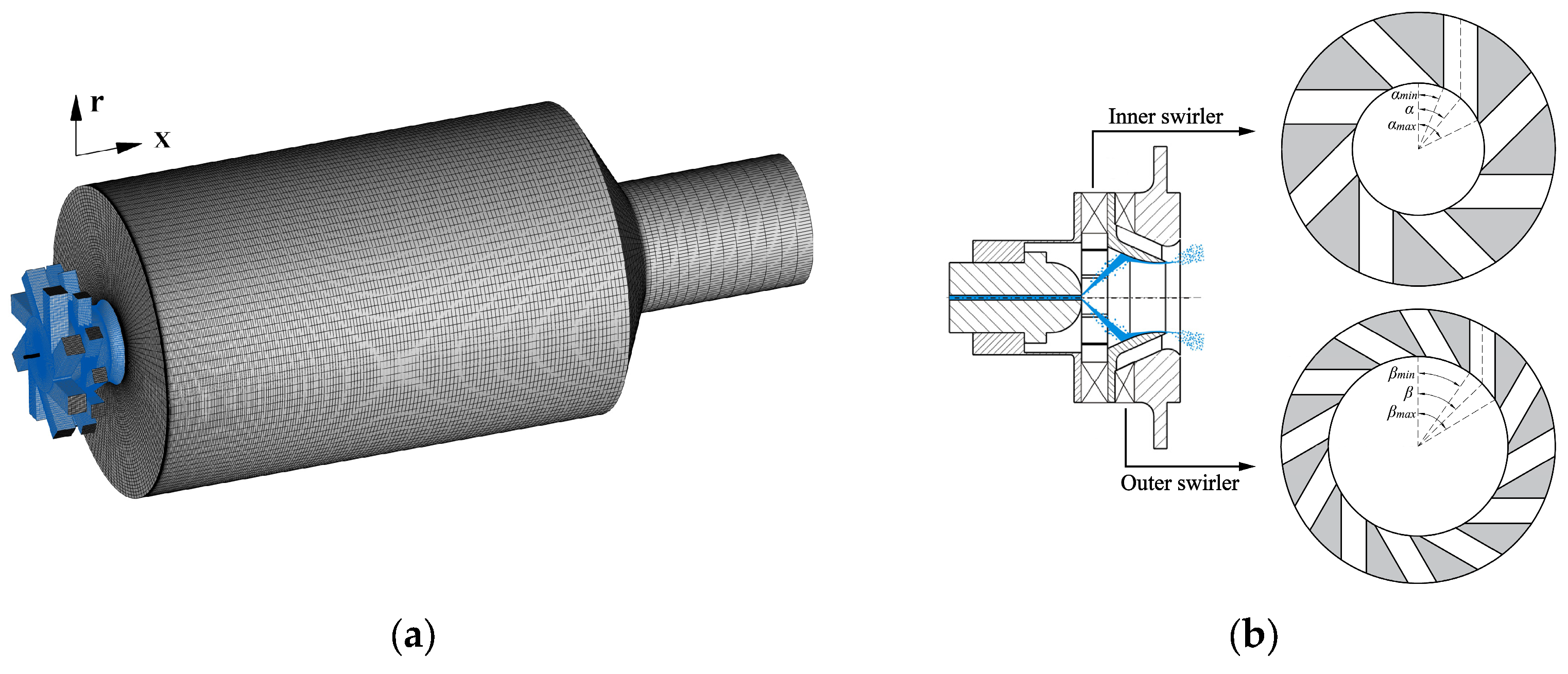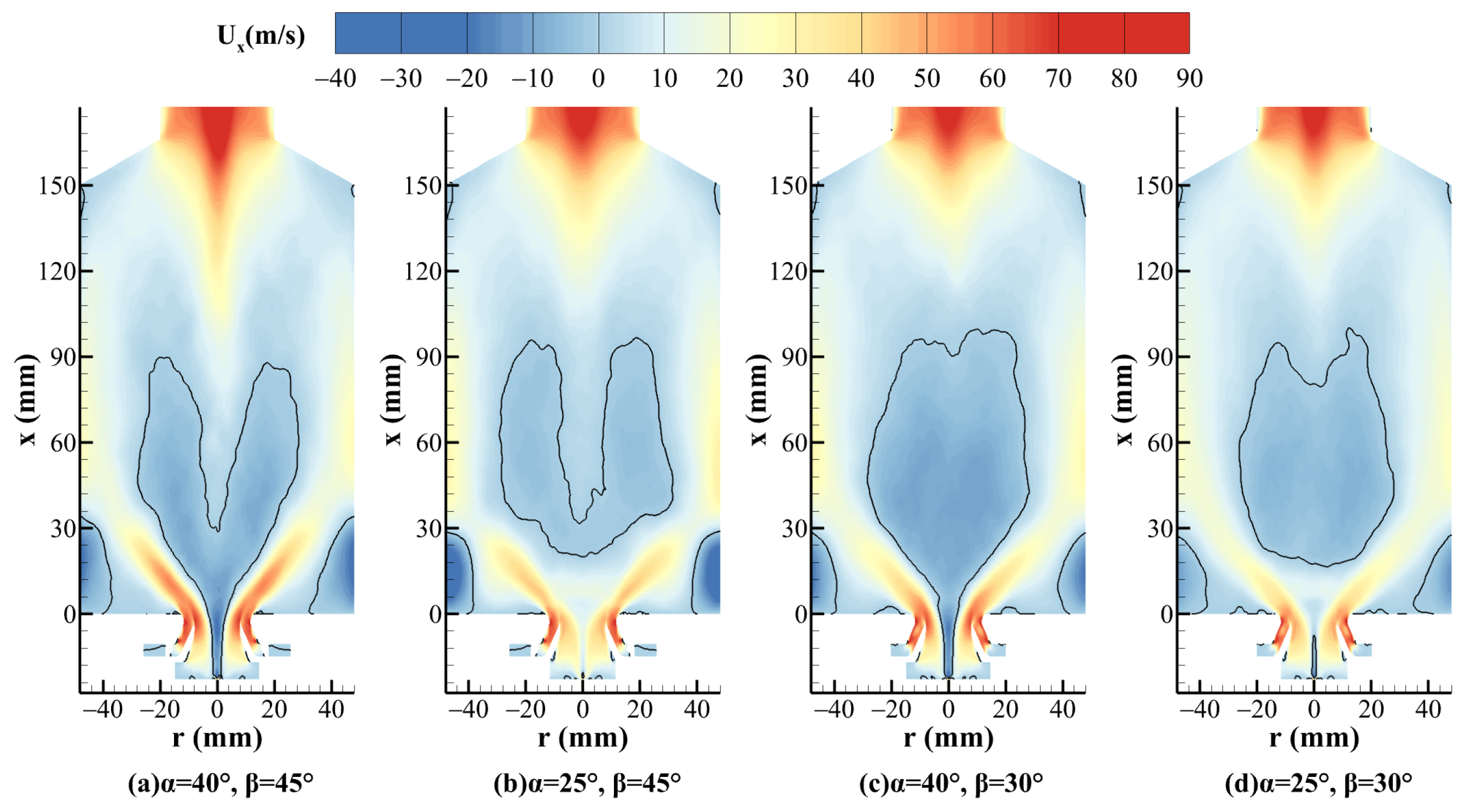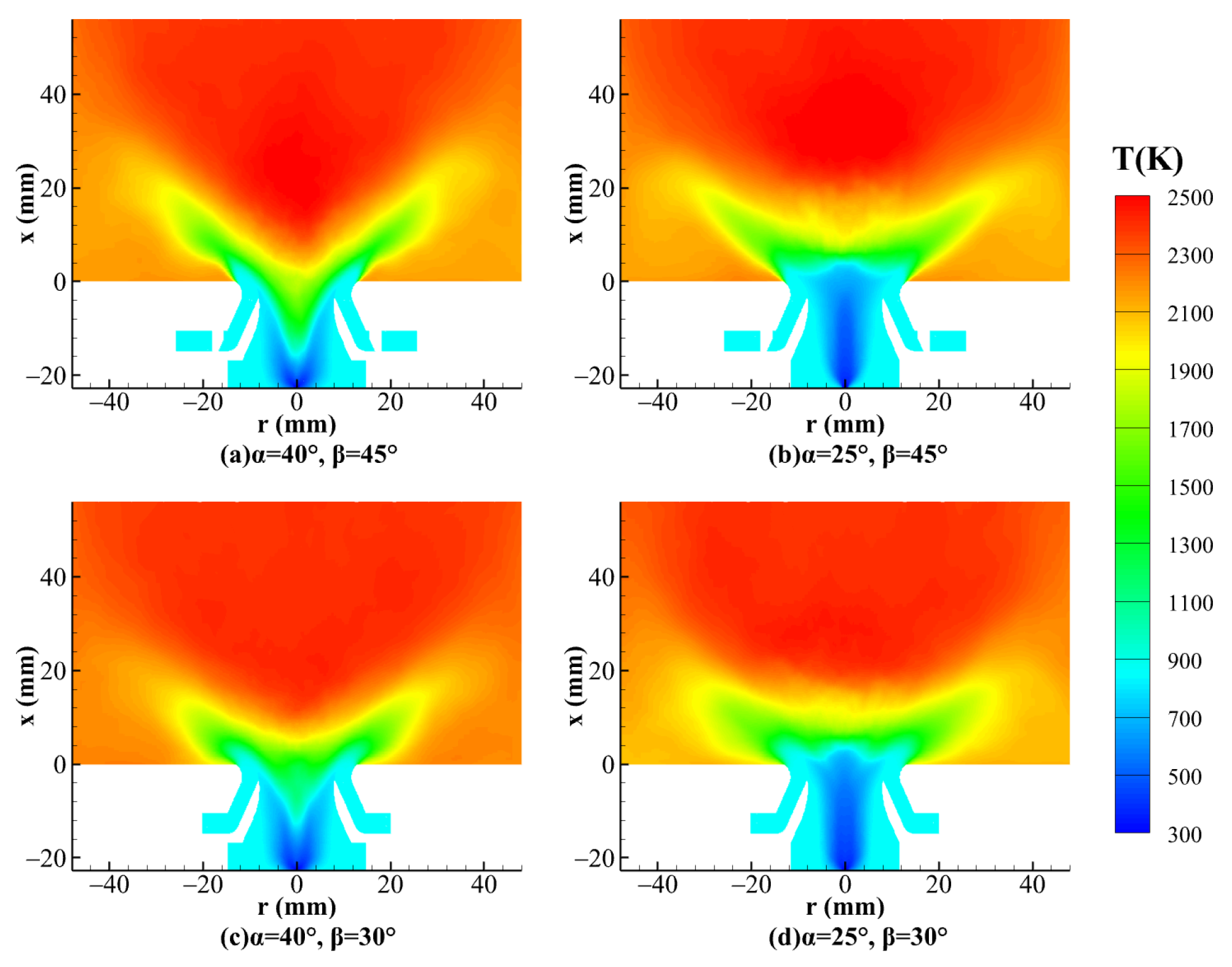Computational Study of the Effect of Dual Air Swirling Injection on Turbulent Combustion of Kerosene–Air at a High Pressure †
Abstract
:1. Introduction
2. Numerical Method
3. Results and Discussion
3.1. Effect of the Inner Air Swirler
3.2. Effect of the Outer Air Swirler
4. Conclusions
Author Contributions
Funding
Institutional Review Board Statement
Informed Consent Statement
Data Availability Statement
Conflicts of Interest
References
- Epstein, A.H. Aircraft engines’ needs from combustion science and engineering. Combust. Flame 2012, 159, 1791–1792. [Google Scholar] [CrossRef]
- Saravanamuttoo, H.I.H.; Rogers, G.F.C.; Cohen, H. Gas Turbine Theory; Pearson education: London, UK, 2001. [Google Scholar]
- Lefebvre, A.H. Gas Turbine Combustion; CRC Press: Boca Raton, FL, USA, 1998. [Google Scholar]
- Syred, N. A review of oscillation mechanisms and the role of the precessing vortex core (PVC) in swirl combustion systems. Prog. Energy Combust. Sci. 2006, 32, 93–161. [Google Scholar] [CrossRef]
- Gicquel, L.Y.M.; Staffelbach, G.; Poinsot, T. Large Eddy Simulations of gaseous flames in gas turbine combustion chambers. Prog. Energy Combust. Sci. 2012, 38, 782–817. [Google Scholar] [CrossRef]
- Huang, D.; Xu, J.; Chen, R.; Meng, H. Large eddy simulations of turbulent combustion of kerosene-air in a dual swirl gas turbine model combustor at high pressures. Fuel 2020, 282, 118820. [Google Scholar] [CrossRef]
- Huang, Y.; Yang, V. Effect of swirl on combustion dynamics in a lean-premixed swirl-stabilized combustor. Proc. Combust. Inst. 2005, 30, 1775–1782. [Google Scholar] [CrossRef]
- Li, S.; Zheng, Y.; Zhu, M.; Martinez, D.M.; Jiang, X. Large-eddy simulation of flow and combustion dynamics in a lean partially premixed swirling combustor. J. Energy Inst. 2017, 90, 120–131. [Google Scholar] [CrossRef]
- Aliyu, M.; Nemitallah, M.A.; Said, S.A.; Habib, M.A. Characteristics of H2-enriched CH4O2 diffusion flames in a swirl-stabilized gas turbine combustor: Experimental and numerical study. Int. J. Hydrog. Energy 2016, 41, 20418–20432. [Google Scholar] [CrossRef]
- Wang, S.; Hsieh, S.-Y.; Yang, V. Unsteady flow evolution in swirl injector with radial entry. I. Stationary conditions. Phys. Fluids 2005, 17, 045106. [Google Scholar] [CrossRef]
- Yang, V. Modeling of supercritical vaporization, mixing, and combustion processes in liquid-fueled propulsion systems. Proc. Combust. Inst. 2000, 28, 925–942. [Google Scholar] [CrossRef]
- Pierce, C.D.; Moin, P. Progress-variable approach for large-eddy simulation of non-premixed turbulent combustion. J. Fluid Mech. 2004, 504, 73–97. [Google Scholar] [CrossRef]
- Meng, H.; Yang, V. A unified treatment of general fluid thermodynamics and its application to a preconditioning scheme. J. Comput. Phys. 2003, 189, 277–304. [Google Scholar] [CrossRef]
- Xu, K.; Meng, H. Analyses of surrogate models for calculating thermophysical properties of aviation kerosene RP-3 at supercritical pressures. Sci. China Technol. Sci. 2015, 58, 510–518. [Google Scholar] [CrossRef]
- Dagaut, P.; Cathonnet, M. The ignition, oxidation, and combustion of kerosene: A review of experimental and kinetic modeling. Prog. Energy Combust. Sci. 2006, 32, 48–92. [Google Scholar] [CrossRef]
- Huang, D.; Wang, Q.; Meng, H. Modeling of supercritical-pressure turbulent combustion of hydrocarbon fuels using a modified flamelet-progress-variable approach. Appl. Therm. Eng. 2017, 119, 472–480. [Google Scholar] [CrossRef]
- Chrigui, M.; Sadiki, A.; Janicka, J.; Hage, M.; Dreizler, A. Experimental and numerical analysis of spray dispersion and evaporation in a combustion chamber. At. Sprays 2009, 19, 929–955. [Google Scholar] [CrossRef]



| Outer Swirler Angle (α) | 45° | 30° | ||
|---|---|---|---|---|
| Inner Swirler Angle (β) | 40° | 25° | 40° | 25° |
| Inner swirl number | 0.556 | 0.448 | 0.613 | 0.449 |
| Maximum axial velocity (m/s) | 63.8 | 43.5 | 60.6 | 52.1 |
| PVC frequency (Hz) | 1736 | 994 | 1763 | 1189 |
| Src | 0.435 | 0.366 | 0.465 | 0.354 |
| SC | 0.783 | 0.816 | 0.759 | 0.813 |
Disclaimer/Publisher’s Note: The statements, opinions and data contained in all publications are solely those of the individual author(s) and contributor(s) and not of MDPI and/or the editor(s). MDPI and/or the editor(s) disclaim responsibility for any injury to people or property resulting from any ideas, methods, instructions or products referred to in the content. |
© 2023 by the authors. Licensee MDPI, Basel, Switzerland. This article is an open access article distributed under the terms and conditions of the Creative Commons Attribution (CC BY) license (https://creativecommons.org/licenses/by/4.0/).
Share and Cite
Huang, D.; Wang, D.; Xu, J.; Meng, H. Computational Study of the Effect of Dual Air Swirling Injection on Turbulent Combustion of Kerosene–Air at a High Pressure. Eng. Proc. 2023, 56, 274. https://doi.org/10.3390/ASEC2023-15265
Huang D, Wang D, Xu J, Meng H. Computational Study of the Effect of Dual Air Swirling Injection on Turbulent Combustion of Kerosene–Air at a High Pressure. Engineering Proceedings. 2023; 56(1):274. https://doi.org/10.3390/ASEC2023-15265
Chicago/Turabian StyleHuang, Dongxin, Danyang Wang, Jianguo Xu, and Hua Meng. 2023. "Computational Study of the Effect of Dual Air Swirling Injection on Turbulent Combustion of Kerosene–Air at a High Pressure" Engineering Proceedings 56, no. 1: 274. https://doi.org/10.3390/ASEC2023-15265






